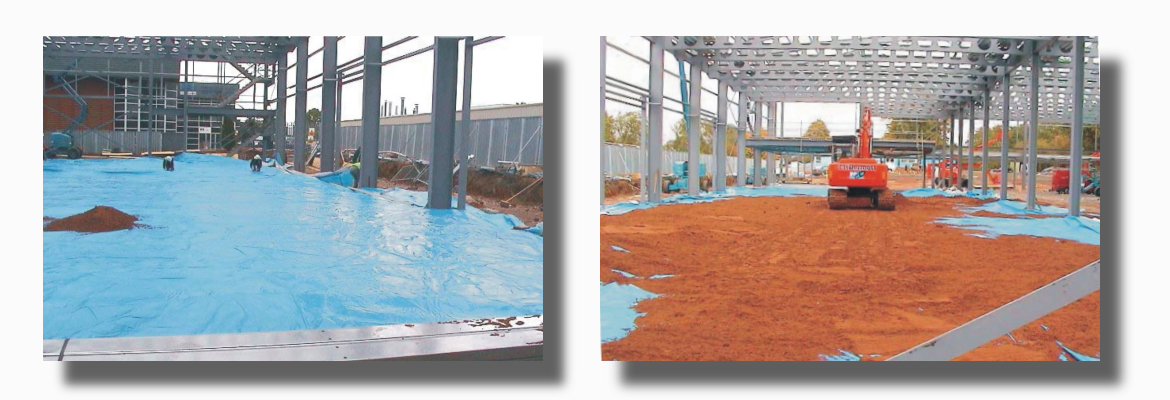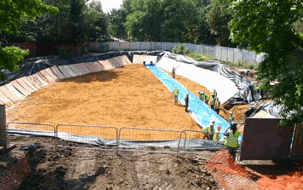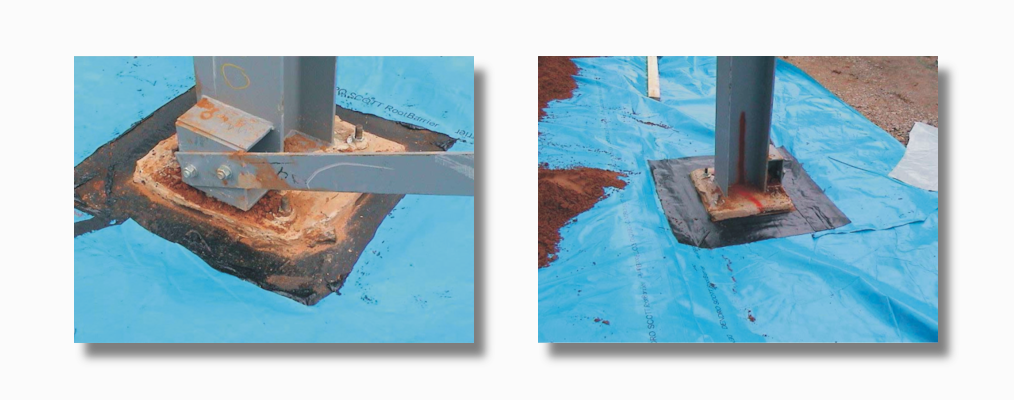What is a root barrier
A root barrier is a special membrane that is installed underground to prevent tree roots, or other pernicious plant roots, such as Japanese Knotweed, spreading. When that happens it can cause costly damage to surrounding buildings, underground pipes and cables, as well as a lot of worry for a homeowner!
When can root barriers be useful?
Root barriers are used as part of best practice in new construction projects, and are also installed regularly in residential plots and gardens to prevent damage. They are either installed…
Vertically, to protect the perimeter of a site or between structures and trees (depending on the distance between the two)
Horizontally, to protect the foundations of new builds and also beneath paths and roads
To create a protective ‘Cell’ to bury Japanese Knotweed contaminated soil on site
To create tree pits that prevent tree roots from damaging paths, roads and foundations. You can read more about our tree pit liners here.
DENDRO-SCOTTTM Root Barrier is a polyethylene-based membrane, known for its flexibility, which makes it easier to install and ‘mould’ to fit the desired shape. It comes in a wide range of sizes and can be jointed on site with tape. Peter Scott Tree Care supplies the UK market for all-sized projects from domestic through to larger custom sizes for new builds.
Why choose DENDRO-SCOTT™ Root Barrier?
- It has no environmental impact to soil
- The barrier membrane is flexible and, therefore, will mould to the desired shape
- It is now available in a wider range of sizes—standard rolls and custom sheets—for large new-builds and smaller residential projects
- It can also be jointed on-site, to create further sizes or uneven shapes
- DENDRO-SCOTT™ Root Barrier membrane is recognised by the Environment Agency and is featured in their Code of Practice for Japanese Knotweed
- The product is the longest established on the market, backed by long-term research and lab testing, and retains exceptional quality performance.
Why does my specifier or architect require a root barrier?
Unfortunately for building projects, a root plate of a tree will tend to develop in areas of soil which are the least compacted and where there is a regular supply of moisture and oxygen. When a trench is excavated for the installation of drains or services, the back filled soil is so well aerated that root development can occur to the bottom of the excavated trench, in and around the drain or service. In addition, it is well known that condensation can form around the outside surface of a drain due to difference in temperatures. This condensation encourages roots to grow around the drains, increasing the risk of root intrusion. The solution, depending on site conditions, is to install a barrier vertically on the side of the trench nearest to the trees. Alternatively, the excavated trench can be lined completely with the root barrier before the drain is installed and sealed with jointing tape.
Root barriers prevent expensive under-pinning or tree loss.
In the past, trees that were causing foundation movement to buildings by drying out the clay soil underneath the foundations were either felled, removing trees from the urban environment, or expensive under-pinning took place. Over the last two decades, Peter Scott Tree Care has developed the technology for the installation of the DENDRO-SCOTT™ Root Barrier. This enables the trees to be retained in their original form, for the benefit of the community, while avoiding the need for costly under-pinning. DENDRO-SCOTT™ Root Barrier was developed over twenty-five years ago and is backed by long-term research.
Look for a root barrier with flexibility and longevity
One of the most important qualities of DENDRO-SCOTT™ Root Barrier is its flexibility. Early research showed that when tree roots reached the root barrier, they tended to mass and develop in a downward direction to the underside of the root barrier, unless there was a good interface between the barrier and the side of the trench. When a rigid or semi-rigid material is used, an unacceptable risk is created that water and/or top soil will percolate around the face of the root barrier, creating the perfect environment for roots to develop down its whole face and eventually go underneath. So it is crucial that the root barrier you choose can stretch and bend to cope with roots growing outwards to some extent, in order to stop them heading straight underneath the bottom of the root barrier line.
Frequently, there is also a need for a root barrier to bisect existing underground services and it is important that the barrier can be cut and effectively resealed to fit around these services, without losing integrity. The DENDRO-SCOTT™ Root Barrier meets these criteria and is the only root barrier with a provenance of over a quarter of a century. In that time there has been not one reported incident of roots breaching the barrier. It is also the only root barrier recommended by the Arboricultural Advisory and Information Service.



